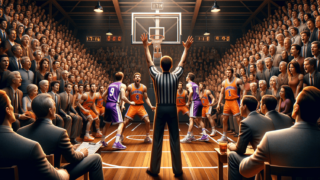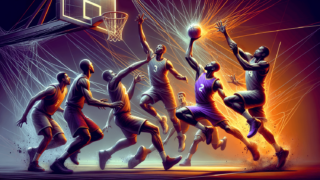
Basketball Three-Point Play Rule: Scoring Big Points
Written by: Basketball Universe
Last updated:

In the fast-paced and exciting world of basketball, one rule stands out as a game changer – the illustrious Three-Point Play. This high-stakes maneuver, combining both finesse and power, has the potential to shift the momentum of a match, rewarding teams who master it with big points and even bigger bragging rights. If you’re a hoops aficionado eager to dive into the nitty-gritty of this essential element of the sport, then you’ve come to the perfect place! Together, we’ll explore the ins and outs of the three-point play, dissecting its history, mechanics, and ultimate impact on modern basketball. So lace up your sneakers, grab your clipboard, and let’s break down this triple-threat play that leaves fans on the edge of their seats!
Basketball Three-Point Play Rule: Scoring Big Points
A three-point play in basketball typically refers to a scenario where a player scores a two-point field goal while getting fouled, then proceeds to score an additional point by converting a subsequent free throw. This play allows the offensive team to earn three points from a single possession, putting immense pressure on the defending team and potentially shifting the momentum of the game.
The Historical Roots of the Three-Point Play
Before we jump into the mechanics of the three-point play, it’s essential to understand its historical roots. The concept of the three-point play was formally introduced in the 1960s, when a committee led by American Basketball Association’s (ABA) commissioner George Mikan implemented the three-point line in the ABA. The NBA adopted the three-point line in the 1979-1980 season, and since then, this game-changing rule has underscored the development of new offensive strategies and styles of play, both at the college and professional level.
The Mechanics of a Three-Point Play
Scoring the Two-Pointer
First things first: a three-point play begins with scoring a two-point field goal. To qualify as a three-point play, the player must be fouled during their shooting motion and still manage to score the basket. This requires a mix of extraordinary skill, concentration, and determination: the player must maintain their focus and follow through on their shot, all while withstanding the contact from their defender.
The Foul
For the play to result in a three-point opportunity, a personal foul must be committed by the defender during the shooter’s act of shooting. The foul can range from a simple push to a more aggressive body contact, but in any case, if the referee deems the defender’s actions as illegal interference, then the shooter will be awarded a free throw regardless of whether the field goal was successful or not.
Converting the Free Throw
If the initial field goal counts and the shooter is awarded a free throw for the foul, the next step is to convert the free throw. This is the final piece of the puzzle for a three-point play, and making this shot allows the offensive team to maximize the value of a single possession. The player has one attempt to make the free throw, facing no defenders, adding the extra pressure of reliance on precision and focus.
Strategy and Execution: Perfecting the Three-Point Play
While a three-point play might appear as a stroke of luck, teams often strategize around it, particularly when they need an extra boost in a close game. By employing specific offensive techniques and capitalizing on a player’s skills, teams can create opportunities for dismantling their opponent’s defense and generating three-point plays.
Penetration and Kickouts
One common strategy that often leads to a three-point play opportunity is penetration and kickouts. A guard, usually with superior ball-handling skills, penetrates the defense, drawing defenders towards him before passing the ball out to an open teammate at the perimeter. This split-second shift of defensive attention creates opportunities for driving lanes, allowing a player to attack the rim and create contact.
Post Play and Mismatches
Another way to create three-point play opportunities is by exploiting mismatches in the post or taking advantage of a dominant post player. In these scenarios, a player with a size or skill advantage establishes position close to the basket and works for a high-percentage shot, forcing the defense to collapse and potentially commit a foul.
Transition Offense
Fast breaks and transition offense can also provide the perfect platform for three-point plays. When a team moves quickly down the court, the defense is often scrambling to get back and set, potentially leading to disorganization and more fouls. Driving aggressively in transition catches the defense off-guard and can result in higher contact and opportunities to score while being fouled.
The Impact of the Three-Point Play on the Game of Basketball
While basketball rules have evolved over time, few are as impactful as the three-point play. Throughout the decades, fans have seen legendary players like Michael Jordan and LeBron James defy physics and athleticism, crafting iconic moments with their acrobatic three-point plays. In recent years, the evolution of basketball has seen a greater emphasis on three-point shooting and floor spacing, which also places added importance on the ability to create and convert three-point plays.
Momentum Swings and Psychological Advantage
A successful three-point play can provide an emotional lift for the team, swinging the momentum in their favor. The shift in dynamics not only impacts the fans in the arena, but also the players on the court—boosting the confidence of the offensive team while casting doubt on the defensive prowess of the opposition.
Statistics and Efficiency
In the modern era of basketball, where advanced metrics and analytics are increasingly shaping coaching decisions, squeezing three points from a single possession is a valuable feat. Executing three-point plays can significantly increase a team’s offensive efficiency and productivity, making them more competitive and, ultimately, more likely to reach the pinnacle of the sport.
Buzzer Beaters and Game Winners
There is no denying that pull-up game-winning three-pointers are spectacular, but a buzzer-beating three-point play can be just as electrifying. By driving to the hoop, drawing a foul, and making the basket at the final seconds of a game, a player can display a rare combination of skill and fearlessness, earning bragging rights for themselves and their team.
Notable Three-Point Play Masters
The NBA has been graced by numerous players who have exhibited exceptional talent in executing and creating three-point plays. These basketball phenoms have not only played crucial roles in crucial moments but have also inspired future generations to push their limits on the court.
Michael Jordan
The legendary Michael Jordan was a master of the three-point play, thanks to his unbelievable hang time, acrobatic finishes, and sheer determination. Opposing teams would often foul Jordan in an attempt to prevent a seemingly inevitable basket, only to find him converting the shots and icing the free throw, further cementing his status as an all-time great.
LeBron James
Combining extraordinary power, agility, and vision, LeBron James has consistently demonstrated his ability to create and convert three-point plays throughout his illustrious career. His unique blend of skills often forces defenders to resort to fouling, but more often than not, LeBron powers through the contact and seals the deal with his free-throw shooting.
Shaquille O’Neal
Although Shaquille O’Neal’s free-throw shooting left much to be desired, his sheer dominance in the post was a prime source of three-point play opportunities. Shaq would muscle his way to the basket with unmatched force, often leaving defenders no choice but to foul in vain attempts to stop him from scoring.
Over the years, the three-point play has emerged as a thrilling and strategic element of basketball. Juxtaposing skill and determination, it continues to be one of the most rewarding plays in the game, casting a vital influence on the outcomes of countless matchups.
Defending Against the Three-Point Play
As coaches and players continually work on improving their offensive tactics to create more three-point play opportunities, the defensive schemes to counter them become just as crucial. Understanding how to reduce the chances of three-point plays can help teams maintain control over the game and reduce the risk of momentum swings in their opponents’ favor.
Smart Positioning and Footwork
One of the most effective ways to counter the threat of a three-point play is by having players maintain proper defensive positioning and employ good footwork. By staying between the offensive player and the basket and moving laterally rather than reaching in, defenders can reduce both the risk of being beaten off the dribble and the likelihood of fouling.
Help Defense and Communication
Effective communication and help defense can contribute significantly to keeping the opposing team’s three-point play opportunities at bay. Fostering trust in teammates and being aware of each other’s positioning on the floor enables players to work collectively, providing assistance when needed to prevent driving lanes while steering clear of compromising fouls.
Foul Management
Managing fouls throughout the game is a vital strategic consideration that can impact a team’s ability to defense against three-point plays. Ensuring that key players avoid early foul trouble and do not become overly aggressive on the defensive end can help minimize the chances of fouling during an opponent’s shot attempt.
Top Three-Point Play Moments in NBA History
Over the course of NBA history, there have been numerous memorable moments featuring incredible three-point plays that have left lasting impressions on both players and fans. Here is a selection of some of the most unforgettable instances where a three-point play was pivotal in defining the game.
Larry Bird’s Iconic Steal and Assist
In Game 5 of the 1987 Eastern Conference Finals, the Boston Celtics were trailing by one point when Larry Bird produced an unforgettable three-point play. Bird stole an inbound pass and dished it off to teammate Dennis Johnson, who scored the basket while drawing a foul. Johnson then hit the ensuing free throw to secure a dramatic victory for the Celtics.
Allen Iverson’s Crossover and Fallaway
Allen Iverson, one of the most skilled ball handlers in NBA history, showcased his impeccable maneuvering during a 76ers game against the Indiana Pacers. After executing a crossover that left his defender stumbling, Iverson drove the lane, launched into a fallaway shot, and sank the basket while getting fouled in the process. Converting the free throw added to the already electrifying scene as he scored a magnificent three-point play.
Kobe Bryant’s Acrobatic Finish
Kobe Bryant, a player synonymous with relentless effort and jaw-dropping acrobatics, stunned the audience during a Lakers game against the Houston Rockets. After a pump fake that sent his defender airborne, Kobe drove past another, absorbed contact mid-air, and converted an improbable reverse layup. With his free throw conversion, this enduring three-point play moment epitomized Kobe’s legacy as a basketball legend.
These remarkable instances of the three-point play serve as testaments to the importance of this rule in shaping the incredible world of basketball. As players push the boundaries of their abilities and teams continue to evolve their strategies around this key play, it is inevitable that future three-point play moments will continue to captivate generations of hoop enthusiasts.
FAQ: Unraveling the Intricacies of the Three-Point Play
As the concept of the three-point play can be quite complex for enthusiasts who are new to the world of basketball, we’ve compiled a list of frequently asked questions to help clarify common misconceptions and provide detailed insights about the subject.
1. Is a three-point play the same as a three-point shot?
No, a three-point play and a three-point shot are not the same. A three-point play occurs when a player scores a two-point field goal, gets fouled during the shooting motion, and then makes the subsequent free throw. A three-point shot is a shot taken from beyond the three-point line and counts for three points if successful.
2. Can a three-point play happen with a three-point shot?
Yes, it is called a four-point play. If a player gets fouled while attempting a three-point shot and the shot is successful, they can earn an additional point by converting a free throw, resulting in a total of four points from a single possession.
3. How often do three-point plays occur in a game?
The frequency of three-point plays depends on the playing style of the teams involved, their level of expertise, and the game’s defensive intensity. There is no fixed number of occurrences; some games may feature several three-point plays, while others might not have any.
4. What is the record for the most three-point plays in a single NBA game or season?
There is no official record maintained specifically for three-point plays. However, players known for their ability to score three-point plays, such as Shaquille O’Neal and LeBron James, would have had games where they converted numerous three-point plays. Data specific to three-point plays in a single game or season remains unavailable.
5. How can I practice scoring a three-point play?
One way to practice scoring a three-point play is by working on finishing layups or close-range shots while absorbing contact from a defender. Focus on maintaining balance, strength in your core, and developing a soft touch on the shot despite being fouled. You should also work on your free throw shooting, as that is an integral part of completing a three-point play.
6. Do offensive players intentionally try to create contact to get a three-point play opportunity?
Yes, many offensive players intentionally seek contact during their shot attempts, especially when they have a high level of confidence in their ability to absorb contact and complete the shot. By creating contact and getting fouled, players can potentially earn a three-point play by making the basket and converting the free throw.
7. What is the most common type of foul that leads to a three-point play?
The most common type of foul that leads to a three-point play is a shooting foul, where the defender makes illegal contact with the offensive player while they are in the act of shooting. This could include reaching in, body contact, or excessive use of force that interferes with a player’s shooting motion.
8. Are certain players more likely to score three-point plays?
Yes, players with proficient driving capabilities and exceptional finishing abilities are more likely to score three-point plays. Strength, agility, and body control play a significant role in drawing fouls and converting field goals under pressure, making athletes with these attributes more likely to excel in scoring three-point plays.
9. How important is the three-point play in winning basketball games?
The three-point play can be an important factor in winning basketball games, especially when the contest is closely matched. Converting a three-point play adds an extra dimension to a team’s offensive options and can swing the momentum in their favor, boosting team morale and potentially affecting the outcome of the game.
10. Can a player still get fouled if they miss the shot and would a free throw still be awarded?
Yes, if a player is fouled during a shot attempt and misses the shot, they will still be awarded free throws, assuming the team is not in the penalty or the foul was not an offensive one. The number of free throws depends on the location of the shot: two free throws for a two-point field goal attempt and three free throws for a three-point attempt.
Featured Posts
- No pillar pages found.





